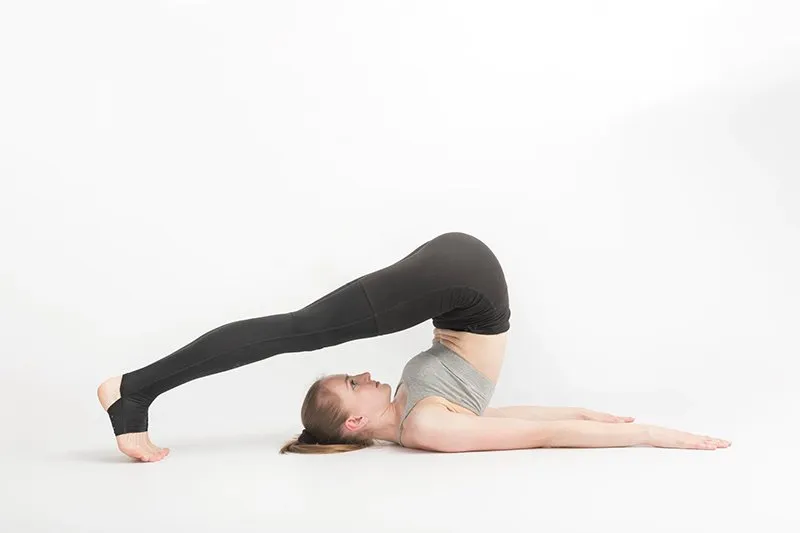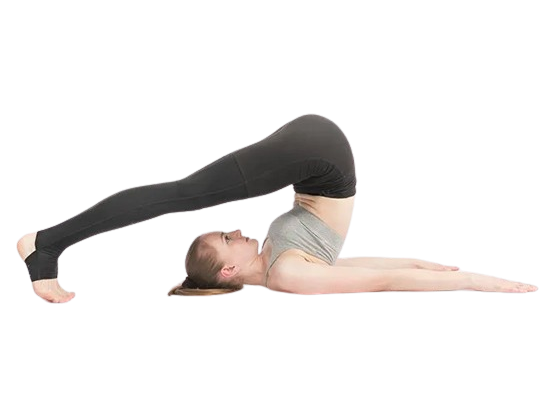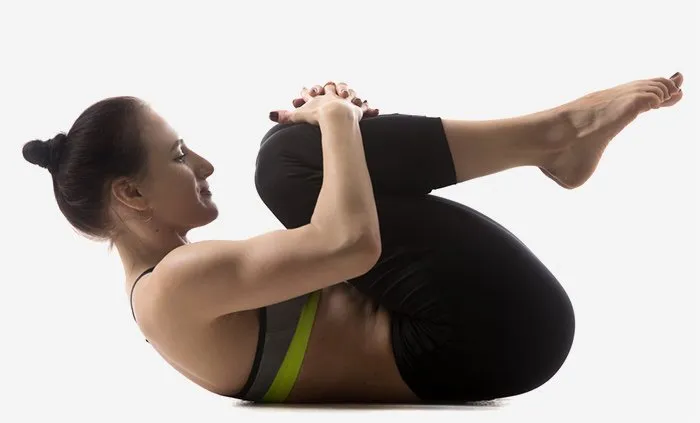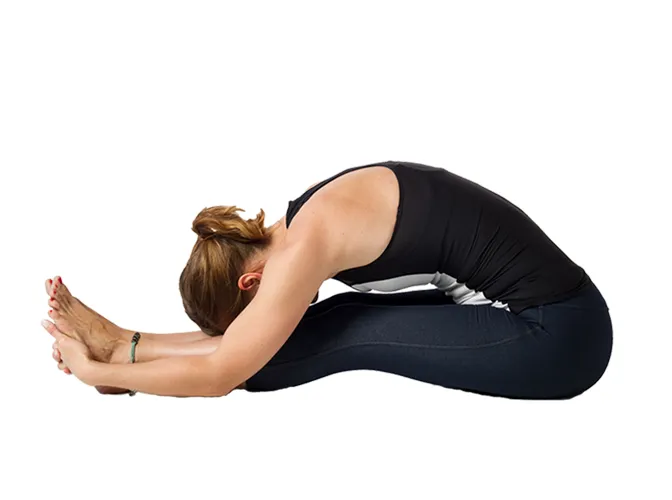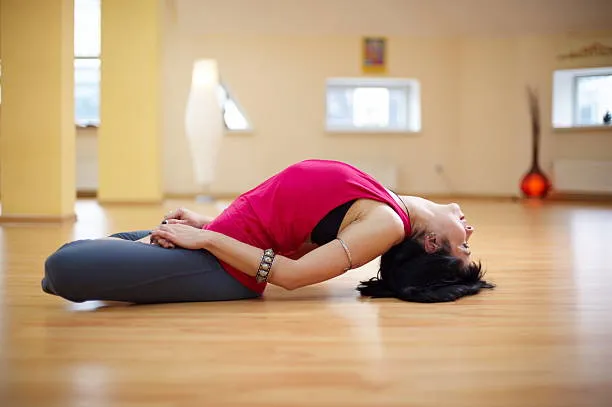On This Page
Halasana – Introduction, Procedure, and Benefits
Introduction
The Sanskrit word Hala means ‘plough’. Halasana is so called because in its final pose it resembles a plow not the modern mechanized plow, but the wooden plough pulled by oxen or bulls that have been used in India since ancient time and is still in use. The resemblance is very close. The English name for this Asana is, not surprisingly, the plow pose.
इस आसन में शरीर की आकृति किसान के “’हल” जैसी बन जाती है। इसीलिए इसे हलासन कहते हैं।
Procedure
- Lie flat on the floor, facing upward.
- The legs should be straight and together and should remain so throughout the practice.
- The palms can face upward or downward, beginners may place their fists under the buttocks with the knuckles facing upwards.
- Relax the whole body and prepare for the practice. Breathe in deeply.
- Then slowly raise the two legs to the vertical position; use the abdominal muscles as much as possible and the arms as little as possible.
- The aim, eventually, is to use only the abdominal muscles to raise the legs without the slightest help of the arms; this may require a little time and practice.
- Then fold the legs over the top of the head, keeping them straight as illustrated. As the legs are raised over the head, the buttocks and hips should also be simultaneously raised.
- Gently lower the feet toward the ground behind the head, but without the slightest strain.
- If possible, touch the toes to the ground behind the head, those who are unable to do this should allow their feet to suspend above the floor. This is the final pose.
विधि
सम्पूर्ण हलासन को दो अवस्थाओं में बांटा जा सकता है।
प्रथम अवस्था –
सबसे पहले आसन पर पैरों को सीधा करके बैठ जाए, दोनों बाजू शरीर के साथ सटे हुए हों तथा हथेलियाँ नीचे की ओर- रखें, फिर दोनों पैरों को सीधा रखते हुए थोड़ा बल लगा कर धीरे-धीरे श्वास भरते हुए 30 डिग्री तक ऊपर उठाएँ इस अवस्था में ५ सैकेण्ड रुकें तदोपरांत पैरों को 90 डिग्री तक धीरे धीरे ले जावें। इसे अर्ध हलासन भी कहते है ।
द्वितीय अवस्था –
अब नितम्बों (Hips) को भूमि से ऊपर उठाकर धीरे-धीरे पैरों को सिर की ओर नीचे ले जाने की कोशिश करें तथा धीरे-धीरे भूमि पर स्पर्श करें, यहां विशेष ध्यान रखें कि घुटने: (knees) मुड़ने न पावें इस stage में 180 डिग्री कोण बन जाता है तथा दोनों पैर सीधे रहे, ठोडी छाती के साथ लगी हुई हो। इस स्थिति में: 5 सैकेण्ड रुके| वापिस आने में बहुत सर्तकता बरतें, धीरे धीरे हथेलियों पर शरीर का भार सन्तुलित करते हुए रीढ़ को भूमि पर धीरे-धीरे लाएं, जब पूरी कमर भूमि पर आ जाए, तो दोनों पैरों को मन्द गति से भूमि की ओर लाऐँ, एडियों को कोमलता से भूमि पर रख दें जितना धीरे-धीरे पैरों को नीचे लाएंगें उतना ही अच्छा प्रभाव पेट के अंगों पर पड़ेगा। वापिस आने पर शरीर ढ़ीला छोड़ दें।

Have A Health Issue?
Consult Online
- Dr. Sahil Gupta (B.A.M.S., M.H.A.)
Ayurvedic Allergy Specialist
CEO & Founder of IAFA®
Benefits
- Halasana gives many benefits that are the same as the Sarvangasana. However, the direct influence on the brain is much less, with more emphasis on the back, abdomen, and pelvis. It combines the benefits of inverted Asanas with forward-bending Asanas.
- Halasana is almost an upside-down form of Paschimottanasana, though there is a distinctive difference between the benefits that they give. Paschimottan Asana acts mainly on the lower back and stretches the back; Halasana, on the other hand, acts mainly on the upper back and neck region.
- These two Asanas supplement each other. Halasana makes the entire spine supple, stretches the muscles, loosens the vertebrae, and tones the nerves both inside and outside the spinal column. This leads to better efficiency of all the organs in the body.
- The thyroid and parathyroid glands work properly if Hala Asana is done routinely. The abdominal muscles are strengthened. The abdominal organs are massaged.
- This helps to alleviate constipation, dyspepsia, diabetes, and various other abdominal ailments. It generally decongests and revitalizes the liver, spleen, kidneys, pancreas, and adrenal glands.
- It helps to remove backache, neck ache, and headache. Besides these physical benefits, Halasana done with attention can induce states of Pratyahara (sense Withdrawal) as a preparation for meditational techniques.
लाभ:
- इस आसन से मेरूदण्ड लचीला बनता है, एवं सुषुम्ना तथा सुषुम्नोत्पनन नाड़ियों के लिए लाभकारी है।
- कद बढ़ाने में सहायता मिलती है।
- समस्त ग्रंथियां kidney, thyroid, parathyroid, spleen, liver, pancreas, Adrenal आदि इस आसन से प्रभावत होती हैं जिससे उन में कार्य क्षमता बढ़ती है।
- श्वास प्रश्वास अधिक अच्छा- होता है जिससे फुफ्फुसों की कार्यक्षमता बढ़ती है।
- पंजों से नितम्ब तक की समस्त मांसपेशियां पुष्ट होती है।
- मोटापा कम. करने में उपयोगी आसन है।
- हृदय का व्यायाम भी हो जाता है।
- पेट के रोगों तथा मधुमेह में लाभ मिलता है।
Contraindication of Hala Asana
- Hypertension (High blood pressure)
- Neck injury
- Pregnancy
- Menstruation period
- Spinal disorder
- Consult a yoga practitioner before performing Hala Asana if you are suffering from Hala Asana.

